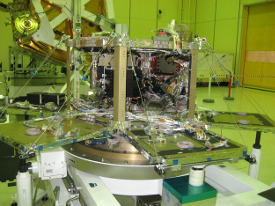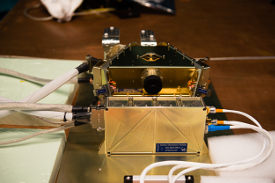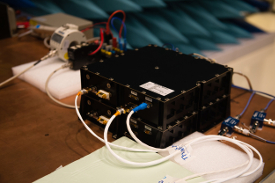#5: Steady progress for CHEOPS
15 September 2016
The CHEOPS mission continues to make steady progress with a number of milestones being successfully met. In the past few months these have included the completion of the System Critical Design Review, the first EMC testing of the instrument, and the first release of the mission operations system.Before the summer, CHEOPS successfully passed the system critical design review (CDR), a key project milestone. This review built on the instrument and ground-segment level CDRs, which had been completed at the beginning of the year, and focussed on the CHEOPS satellite, its internal and external interfaces, as well as the mission-level schedule. The main review objectives were to confirm that the detailed system design meets the mission requirements, and that the schedule is compatible with the proposed launch schedule.
The CDR typically marks the transition from detailed design phase to manufacturing, however given the accelerated schedule that CHEOPS is following, manufacture of flight hardware both at platform and instrument level has already started, specifically those elements that already have flight heritage.
The next major review at system level will be the Qualification/Acceptance Review that will take place in the months leading up to launch.
In parallel to the review process, procurement of the flight equipment and preparation of the satellite platform have progressed further. The platform structure has been prepared for integration of the flight units and has been equipped with the flight harness. It has also undergone a bake-out in a thermal vacuum chamber. The bake-out is performed to allow materials to out-gas, thus improving the overall cleanliness levels that can be achieved during future test activities.
Shortly after the bake-out, the platform was transferred to the cleanroom of ADS-ECE (Airbus Defence and Space - EADS CASA Espacio), and the mechanical integration of the flight equipment began.
The Engineering Model of the CHEOPS payload electronics arrived at the European Space Research and Technology Centre (ESTEC) in the Netherlands on 26 June, accompanied by a team of engineers from the Universities of Graz (Austria), Bern (Switzerland), and Vienna (Austria), as well as from the German Aerospace Centre (DLR), Berlin (Germany).
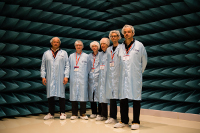 |
| Some of the CHEOPS Instrument Team. Credit: ESA/C.Carreau |
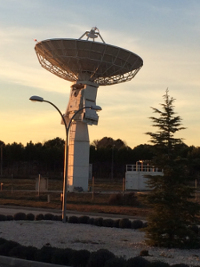 |
| Ground station at Torrejón de Ardoz. Credit: ESA/N. Rando |
The task for the week was electromagnetic compatibility (EMC) testing. The complete electronics of the instrument, which includes the Back-End Electronic (BEE), Sensor Electronic Module (SEM) and Focal Plane Module (FPM), were tested. Tests to demonstrate that the instrument is compatible with the platform electronics, and compliant with requirements for conducted emission and radiated emission were successfully completed.
Particularly appreciated by the instrument team was the collaboration with ESTEC Test Centre colleagues who are in charge of the EMC facility and who carried out the EMC tests in a very efficient way. ESTEC EMC experts also supported the instrument team during the test.
This marks a major milestone in the development of the CHEOPS instrument, allowing the instrument team to progress with the procurement and assembly of the flight electronics.
In the previous journal article we reported on the successful testing of the interfaces between the CHEOPS primary ground station antenna at Torrejón de Ardoz (Spain) and a test model of the CHEOPS transceiver. These same tests were repeated, successfully, at the end of June at the European Space Operations Centre (ESOC), in Darmstadt (Germany), confirming the compatibility of CHEOPS with the ESA ground station in Kiruna, Sweden, which will be used during launch and early operations.
In early July the first release of the mission operations and control system was installed at the CHEOPS Mission Control Centre at INTA, in Torrejón de Ardoz, Spain, and successfully tested. This test represents a key milestone for the CHEOPS ground segment.
About CHEOPS
CHEOPS is an ESA mission implemented in partnership with Switzerland, through the Swiss Space Office (SSO). The University of Bern leads a consortium of 11 ESA Member States contributing to the mission and represented in the CHEOPS Science Team. ESA is the mission architect responsible for overall mission definition and procurement of the spacecraft and launch. ESA is also responsible for early operations phase that will be executed by the spacecraft contractor, EADS CASA Espacio S.L., which is part of Airbus Defence and Space. The science instrument is led by the University of Bern, with important contributions from Austria, Belgium, Germany and Italy. Other contributions to the science instrument, in the form of hardware or science operations, are provided by Hungary and by France, Portugal, Sweden and the United Kingdom respectively. Following successful in-orbit commissioning of the spacecraft, responsibility for operations will be taken over by the CHEOPS Mission Consortium, with the Mission Operations Centre under the responsibility of Spain and the Science Operations Centre led by and located at the University of Geneva, Switzerland.


